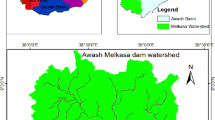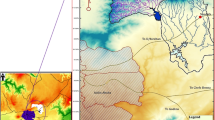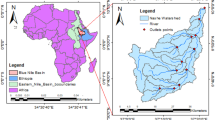Abstract
Soil erosion and silt deposition have caused significant problems in the Ethiopian highlands, particularly in the Upper Blue Nile Basin (UBNB), reducing the service life of reservoirs in the region. To develop effective mitigation strategies, it is essential to understand the sediment yield in the region and identify the hotspot areas. The Modified Universal Soil Loss Equation in Soil and Water Assessment Tool Plus (SWAT Plus) was used to simulate streamflow and sediment yield and identify the hotspot spatiotemporal variability of sediment yield in the UBNB at different reservoir catchments. The QSWAT Plus model is implemented by utilizing the digital elevation model, climate and weather generation data, land use, soil type, and slope of the UBNB. The Sobol tool algorithm, part of the SWAT Toolbox’s calibration and uncertainty analysis programs, is used to calibrate and verify streamflow and sediment yield monthly. The model exhibited satisfactory performance across all the watersheds studied. The Kessie watershed exhibited significant spatiotemporal variation in sediment yield. The spatial variation of sediment output across different catchments within the watershed ranged from 0 to 67.6t/ha/yr. 42.04% of the watershed area is a critical erosion region and 39.48% of the watershed is sub critical region. This significant spatial variability in sediment yield is attributed to a combination of human activities and environmental factors in the region. The extremely high sediment yield values observed in the parts of the watershed have serious negative consequences for the longevity and functioning of numerous reservoirs located in the Ethiopian highlands. Approximately 90% of the total yearly sediment load was recorded during the winter season. According to the simulation results, implementing filter strips, terraces, and contour procedures within the watershed could drastically lower watershed sediment yield by 58.67%, 93.685%, and 64.46%, respectively. The chosen best management practices (BMPs) have proven to be very effective in reducing sediment discharge in watershed-vulnerable areas. Based on the percentage reduction in sediment, it was concluded that terracing was the most effective strategy for the affected subbasins compared to other watershed management approaches. This study found that BMPs are effective at reducing sediment transport and could be used to reduce reservoir sedimentation in the UBNB.










Similar content being viewed by others
Data availability
No datasets were generated or analysed during the current study.
References
Abbaspour KC, Rouholahnejad E, Vaghefi S et al (2015) A continental-scale hydrology and water quality model for Europe: calibration and uncertainty of a high-resolution large-scale SWAT model. J Hydrol 524:733–752. https://doi.org/10.1016/j.jhydrol.2015.03.027
Alebachew M, Sewnet A (2024) Remote sensing applications: society and environment modeling the impact of land use land cover change on the Estimation of soil loss and sediment export using invest model at the rib watershed of upper blue nile basin, Ethiopia. Remote Sens Appl Soc Environ 34:101177. https://doi.org/10.1016/j.rsase.2024.101177
Anteneh Y, Alamirew T, Zeleke G, Kassawmar T (2023) Modeling runoff – sediment influx responses to alternative BMP interventions in the Gojeb watershed, Ethiopia, using the SWAT hydrological model. Environ Sci Pollut Res, 22816–22834. https://doi.org/10.1007/s11356-022-23711-4
Arnold JG, Bieger K, White MJ et al (2018) Use of decision tables to simulate management in SWAT+. Water (Switzerland) 10:1–10. https://doi.org/10.3390/w10060713
Asselman NEM (2000) Fitting and interpretation of sediment rating curves. J Hydrol 234:228–248. https://doi.org/10.1016/S0022-1694(00)00253-5
Augusto C, Santos G (2008) No title, 2. https://doi.org/10.4090/juee.2008.v2n1.021027
Ayele GT, Kuriqi A, Jemberrie MA et al (2021) Sediment yield and reservoir sedimentation in highly dynamic watersheds: the case of Koga reservoir, Ethiopia. Water (Switzerland) 13:1–20. https://doi.org/10.3390/w13233374
Bachiller AR, Rodríguez JLG, Sánchez JCR, Gómez DL (2019) Specific sediment yield model for reservoirs with medium-sized basins in Spain: an empirical and statistical approach. Sci Total Environ 681:82–101. https://doi.org/10.1016/j.scitotenv.2019.05.029
Bai J, Shen Z, Yan T (2017) A comparison of single- and multi-site calibration and validation: a case study of SWAT in the Miyun reservoir watershed, China. Res Article 11:592–593. https://doi.org/10.1007/s11707-017-0656-x
Betrie GD, Mohamed YA, Griensven A, Van, Srinivasan R (2011) Sediment management modelling in the blue nile basin using SWAT model, 807–818. https://doi.org/10.5194/hess-15-807-2011
Bieger K, Arnold JG, Rathjens H et al (2017) Introduction to SWAT+, A completely restructured version of the soil and water assessment tool. J Am Water Resour Assoc 53:115–130. https://doi.org/10.1111/1752-1688.12482
Bihonegn BG, Awoke AG (2023) Evaluating the impact of land use and land cover changes on sediment yield dynamics in the upper Awash basin, Ethiopia the case of Koka reservoir. Heliyon 9:e23049. https://doi.org/10.1016/j.heliyon.2023.e23049
Billi P (2015) Landscapes and landforms of Ethiopia
Briak H, Moussadek R, Aboumaria K, Mrabet R (2016) International soil and water conservation research assessing sediment yield in Kalaya gauged watershed (Northern Morocco) using GIS and SWAT model. Int Soil Water Conserv Res 4:177–185. https://doi.org/10.1016/j.iswcr.2016.08.002
Chelkeba Tumsa B (2023) The response of sensitive LULC changes to runoff and sediment yield in a semihumid urban watershed of the upper awash Subbasin using the SWAT + model, Oromia, Ethiopia. Appl Environ Soil Sci 2023. https://doi.org/10.1155/2023/6856144
Dibaba WT, Demissie TA, Miegel K (2021) Evaluation of best management practices in highland Ethiopia, Finchaa catchment
Documentation T (2009) Soil & water assessment tool theoretical documentation version 2009
Dutta S, Sen D (2018) Application of SWAT model for predicting soil erosion and sediment yield. Sustain Water Resour Manag 4:447–468. https://doi.org/10.1007/s40899-017-0127-2
Easton ZM, Fuka DR, White ED et al (2010) Sciences A multi basin SWAT model analysis of runoff and sedimentation in the Blue Nile, Ethiopia, 1827–1841. https://doi.org/10.5194/hess-14-1827-2010
Endalew L, Mulu A (2022) Estimation of reservoir sedimentation using bathymetry survey at shumburit Earth dam, East Gojjam zone Amhara region. Ethiopia Heliyon 8:e11819. https://doi.org/10.1016/j.heliyon.2022.e11819
Fazzini M, Bisci C, Billi P (2015) The climate of Ethiopia. World Geomorphol Landscapes, 65–87. https://doi.org/10.1007/978-94-017-8026-1
Gashaw T, Worqlul AW, Dile YT et al (2020) Evaluating potential impacts of land management practices on soil erosion in the Gilgel Abay watershed, upper blue nile basin. Heliyon 6:e04777. https://doi.org/10.1016/j.heliyon.2020.e04777
Gashaw T, Dile YT, Worqlul AW et al (2021) Evaluating the effectiveness of best management practices on soil Erosion reduction using the SWAT model: for the case of Gumara watershed, abbay (Upper blue Nile) basin. Environ Manage 68:240–261. https://doi.org/10.1007/s00267-021-01492-9
Gessesse B, Bewket W, Bräuning A (2015) Model-Based characterization and monitoring of runoff and soil Erosion in response to land use/land cover changes in the Modjo watershed, Ethiopia. L Degrad Dev 26:711–724. https://doi.org/10.1002/ldr.2276
Hard E, Zy R, Hiroshi I et al (2024) Uncorrected proof Multi-gauge calibration comparison for simulating stream Fl Ow across the major river uncorrected proof. https://doi.org/10.2166/nh.2024.188
Haregeweyn N, Poesen J, Nyssen J et al (2006) Reservoirs in Tigray (Northern Ethiopia): characteristics and sediment deposition problems. L Degrad Dev 17:211–230. https://doi.org/10.1002/ldr.698
Haregeweyn N, Poesen J, Nyssen J et al (2008) Sediment yield variability in Northern Ethiopia: A quantitative analysis of its controlling factors. CATENA 75:65–76. https://doi.org/10.1016/j.catena.2008.04.011
Haregeweyn N, Tsunekawa A, Poesen J et al (2015) Reservoir sedimentation channel stabilization, 227–238. https://doi.org/10.1007/978-94-017-8026-1
Haregeweyn N, Tsunekawa A, Poesen J et al (2017) Comprehensive assessment of soil erosion risk for better land use planning in river basins: case study of the upper blue nile river. Sci Total Environ 574:95–108. https://doi.org/10.1016/j.scitotenv.2016.09.019
Hordofa AT, Leta OT, Alamirew T, Chukalla AD (2023) Climate change impacts on blue and green water of Meki river Sub-Basin. Water Resour Manag 37:2835–2851. https://doi.org/10.1007/s11269-023-03490-4
Hurni H, Tato K, Zeleke G (2005) The implications of changes in population, land use, and land management for surface runoff in the upper nile basin area of Ethiopia. Mt Res Dev 25:147–154. https://doi.org/10.1659/0276-4741(2005)025[0147:TIOCIP]2.0.CO;2
Jilo NB, Gebremariam B, Harka AE et al (2019) Evaluation of the impacts of climate change on sediment yield from the Logiya watershed, lower Awash basin, Ethiopia. Hydrology 6:81. https://doi.org/10.3390/hydrology6030081
Kefay T, Abdisa T, Tumsa BC (2022) Prioritization of susceptible watershed to sediment yield and evaluation of best management practice: a case study of Awata 2022
Kidane M, Bezie A, Kesete N, Tolessa T (2019) The impact of land use and land cover (LULC) dynamics on soil erosion and sediment yield in Ethiopia. Heliyon 5:e02981. https://doi.org/10.1016/j.heliyon.2019.e02981
Koltsida E, Mamassis N, Kallioras A (2021) Hydrological modeling using the SWAT model in urban and peri- urban environments: the case of Kifissos experimental sub-basin, 1–24
Konan-waidhet AB (2023) Using the SWAT + model to assess the conditions of water inflow to a reservoir in an uncontrolled agricultural catchment. Case study of the Nanan reservoir in the lake Taabo catchme. Ecohydrol Hydrobiol. https://doi.org/10.1016/j.ecohyd.2023.08.002
Lemma H, Adgo E, Poesen J, Nyssen J (2019) Identifying erosion hotspots in lake Tana basin from a multisite soil and water assessment tool validation: opportunity for land managers, 1449–1467. https://doi.org/10.1002/ldr.3332
Leta MK, Waseem M, Rehman K, Tränckner J (2023) Sediment yield Estimation and evaluating the best management practices in Nashe watershed, blue nile basin, Ethiopia. Environ Monit Assess 195. https://doi.org/10.1007/s10661-023-11337-z
Mekonnen M, Keesstra SD, Baartman JE et al (2015) Evaluating sediment storage dams: structural off-site sediment trapping measures in northwest Ethiopia 41:7–22. https://doi.org/10.18172/cig.2643
Mosbahi M, Benabdallah S (2020) Assessment of land management practices on soil erosion using SWAT model in a Tunisian semi-arid catchment. J Soils Sediments 20:1129–1139. https://doi.org/10.1007/s11368-019-02443-y
Munoth P, Goyal R (2019) Impacts of land use land cover change on runoff and sediment yield of upper Tapi river Sub-Basin. Intl J River Basin Manag 0:1–13. https://doi.org/10.1080/15715124.2019.1613413
Negewo TF, Sarma AK (2021) Spatial and Temporal variability evaluation of sediment yield and sub-basins / hydrologic response units prioritization on Genale. J Hydrol 603:127190. https://doi.org/10.1016/j.jhydrol.2021.127190
Negewo TF, Sarma AK (2023) Sustainable and Cost-Effective management of degraded Sub-Watersheds using ecological management practices (EMPs) for Genale basin, Ethiopia. J Hydrol 619:129289. https://doi.org/10.1016/j.jhydrol.2023.129289
Nyssen J, Poesen J, Moeyersons J et al (2004) Human impact on the environment in the Ethiopian and Eritrean highlands — a state of the art. 64:273–320. https://doi.org/10.1016/S0012-8252(03)00078-3
Pandey A, Himanshu SK, Mishra SK, Singh VP (2016) Catena physically based soil erosion and sediment yield models revisited. CATENA 147:595–620. https://doi.org/10.1016/j.catena.2016.08.002
Perera D, Williams S, Smakhtin V (2023) Present and future losses of storage in large reservoirs due to sedimentation: a country-wise global assessment. Sustain 15. https://doi.org/10.3390/su15010219
Risal A, Parajuli PB (2022) Evaluation of the impact of best management practices on streamflow, sediment and nutrient yield at field and watershed scales. Water Resour Manag 36:1093–1105. https://doi.org/10.1007/s11269-022-03075-7
Sab-basin UA, Daba MH (2018) Sensitivity of SWAT simulated runoff to temperature and rainfall in the upper Awash Sab-Basin, Ethiopia. Hydrology 9:1–7. https://doi.org/10.4172/2157-7587.1000293
Sinshaw BG, Belete AM, Mekonen BM, Wubetu TG (2021) Watershed-based soil erosion and sediment yield modeling in the rib watershed of the upper blue nile basin, Ethiopia Watershed-based soil erosion and sediment yield modeling in the rib watershed of the upper blue nile basin, Ethiopia. Energy Nexus 3:100023. https://doi.org/10.1016/j.nexus.2021.100023
Taylor P, Chandra P, Patel PL et al (2014) ISH journal of hydraulic engineering Estimation of sediment yield using SWAT model for upper Tapi basin. 37–41. https://doi.org/10.1080/09715010.2014.902170
Tebebu TY, Abiy AZ, Zegeye AD et al (2010) Surface and subsurface flow effect on permanent gully formation and upland erosion near lake Tana in the Northern highlands of Ethiopia, pp 2207–2217. https://doi.org/10.5194/hess-14-2207-2010
Tesema TA, Leta OT (2020) Sediment yield Estimation and effect of management options on sediment yield of kesem dam watershed, Awash basin, Ethiopia. Sci Afr 9:e00425. https://doi.org/10.1016/j.sciaf.2020.e00425
Tessema YM, Zimale FA, Kebedew MG (2024) Understanding sedimentation trends to enhance sustainable reservoir management in the Angereb reservoir, upper blue nile basin, Ethiopia. Front Water 6. https://doi.org/10.3389/frwa.2024.1387915
Tibebe D, Bewket W (2011) Surface runoff and soil erosion Estimation using the SWAT model in the Keleta watershed, Ethiopia. L Degrad Dev 22:551–564. https://doi.org/10.1002/ldr.1034
Tsegaye L, Bharti R (2021) Soil erosion and sediment yield assessment using RUSLE and GIS-based approach in Anjeb watershed, Northwest Ethiopia. SN Appl Sci 3:1–19. https://doi.org/10.1007/s42452-021-04564-x
Tumsa BC, Kenea G, Tola B (2022) Heliyon the application of SWAT Þ model to quantify the impacts of sensitive LULC changes on water balance in Guder catchment. Oromia Ethiopia Heliyon 8:e12569. https://doi.org/10.1016/j.heliyon.2022.e12569
Tumsa BC, Feyessa FF, Tullu KT, Guder AC (2023) Spatiotemporal changes of land use in response to runoff and sediment yield for environmental sustainability in the upper blue nile basin, Oromiyaa, Ethiopia. H2Open 6:551–575. https://doi.org/10.2166/h2oj.2023.072
Vigiak O, Malagó A, Bouraoui F et al (2015) Adapting SWAT hillslope erosion model to predict sediment concentrations and yields in large basins. Sci Total Environ 538:855–875. https://doi.org/10.1016/j.scitotenv.2015.08.095
Vigiak O, Malagó A, Bouraoui F et al (2017) Modelling sediment fluxes in the Danube river basin with SWAT. Sci Total Environ 599–600:992–1012. https://doi.org/10.1016/j.scitotenv.2017.04.236
Yen H, Park S, Arnold G et al (2019) IPEAT +: A Built-In Optimization and Automatic Calibration Tool of SWAT +. 1–17
Yesuph AY, Dagnew AB (2019) Soil erosion mapping and severity analysis based on RUSLE model and local perception in the beshillo catchment of the blue nile basin, Ethiopia. Environ Syst Res 8:1–21. https://doi.org/10.1186/s40068-019-0145-1
Zantet o M, Takele S, Eliyas A (2023) Evaluation of best management practices to reduce sediment yield in the upper Gilo watershed, Baro Akobo basin, Ethiopia using SWAT. Heliyon 9:e20326. https://doi.org/10.1016/j.heliyon.2023.e20326
Shahin MMA (1993) An overview of reservoir sedimentation in some African river basins. Sediment Problems Strategy Monitoring Predict Control (Proc Yokohama Symp) 93–100.
Moriasi DN, Arnold JG, Liew MW Van, et al (2007) Model evaluation guidelines for systematic quantification of accuracy in watershed simulations. Am Soc Agric Biol Eng ISSN 0001–2351 885:885–900.
Acknowledgements
we would like to thank the staff of the hydrology department under the Ministry of Water and Energy, and the Ethiopia Meteorological Institute (EMI) for providing data on streamflow, sediment, and climate.
Funding
No funding was received for this research.
Author information
Authors and Affiliations
Contributions
Bayu Geta Bihonegn: Conceptualisation, Data curation, Formal analysis, Writing—original draft, writing—review & editing, Admasu Gebeyehu Awoke: Supervision, Writing—Review & Editing.
Corresponding author
Ethics declarations
Competing interests
The authors declare no competing interests.
Conflict of interest
The author declares that there are no conflicts of interest regarding the publication of this article.
Additional information
Communicated by Hassan Babaie.
Publisher’s note
Springer Nature remains neutral with regard to jurisdictional claims in published maps and institutional affiliations.
Rights and permissions
Springer Nature or its licensor (e.g. a society or other partner) holds exclusive rights to this article under a publishing agreement with the author(s) or other rightsholder(s); author self-archiving of the accepted manuscript version of this article is solely governed by the terms of such publishing agreement and applicable law.
About this article
Cite this article
Bihonegn, B.G., Awoke, A.G. Spatiotemporal sediment yield variability in the Upper Blue Nile Basin, Ethiopia. Earth Sci Inform 18, 319 (2025). https://doi.org/10.1007/s12145-025-01821-0
Received:
Accepted:
Published:
DOI: https://doi.org/10.1007/s12145-025-01821-0




